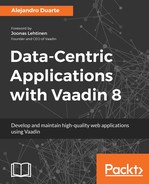The following sections show how to implement CRUD views using two different designs: a Grid in editable mode, and modal windows. But first, we need to implement a domain model. We'll use JPA and repository classes, which we explained in the previous chapters. The domain model consists of simple classes to model a role-based schema: User, and Role. It also includes the corresponding UserRepository and RoleRepository classes.
Let's start with the simplest of the classes, Role. The following is the full implementation of this class:
@Entity
@Data
public class Role {
@Id
@GeneratedValue
private Long id;
private String name;
private Boolean module1Authorized;
private Boolean module2Authorized;
@Override
public String toString() {
return name;
}
}
Besides the usual JPA configuration stuff (such as the @Entity, @Id, and @GeneratedValue annotations), the most interesting thing in this class is that there are no getters and setters. Nevertheless, getters and setters for each Java field in the class exist! This is thanks to Project Lombok, a library that reduces the amount of boilerplate code needed in Java programs. Lombok generates code at the class level. In the previous class, we used the @Data annotation in order to tell Lombok to generate getters and setters, and toString, equals, and hashCode methods. Since the toString method generated by Lombok doesn't fit our requirements, we override it and provided a custom one.
In order to use Lombok, you need to install it in your IDE, and add the dependency to the pom.xml file:
<dependency>
<groupId>org.projectlombok</groupId>
<artifactId>lombok</artifactId>
<version>1.16.18</version>
<scope>provided</scope>
</dependency>
You can find installation instructions for IntelliJ IDEA, NetBeans, Eclipse, and other IDEs at: https://projectlombok.org. After installing Lombok, you'll be able to use autocomplete and any other features of your IDE in order to use the generated code, even when you don't see it in the Java class. For example, the following screenshot shows IntelliJ IDEA suggesting the generated getName method when using the autocomplete feature:

The following is the implementation of the User class, which uses Lombok as well:
@Entity
@Data
public class User {
@Id
@GeneratedValue
private Long id;
private String firstName;
private String lastName;
private String email;
private String password;
private boolean blocked;
@ManyToMany(fetch = FetchType.EAGER)
private Set<Role> roles;
@ManyToOne
private Role mainRole;
}
Notice the @ManyToMany annotation in the roles field. What's the difference between @ManyToMany and @OneToMany? The -ToMany part means that every User can be associated with many Role objects. The @Many- part means that every Role can have many User instances. If @OneToMany was used, the @One- part would mean that every Role can be associated with only one User, which is clearly not what we want in this model.
The last part of the domain model is the repository classes. For the RoleRepository class, we only need a method to find all the Role objects, and another to save a new one, as shown in the following snippet of code:
public class RoleRepository {
public static List<Role> findAll() { ... }
public static Role save(Role role) { ... }
}
And for completeness, the following are the methods in the UserRepository class:
public class UserRepository {
public static List<User> findAll() { ... }
public static User findById(Long id) { ... }
private static User getById(Long id, EntityManager em) { ... }
public static User save(User user) { ... }
public static void delete(User user) { ... }
}
